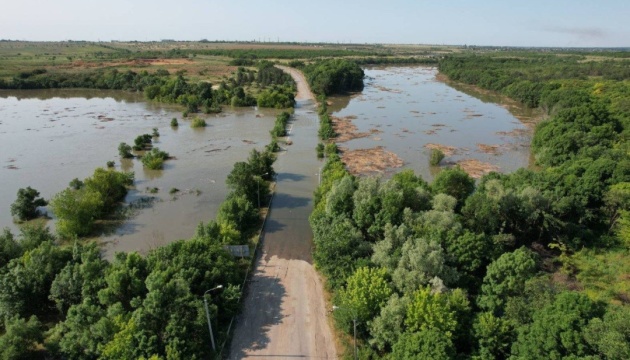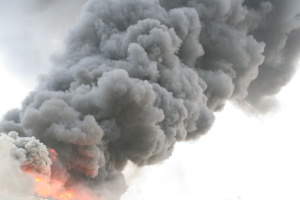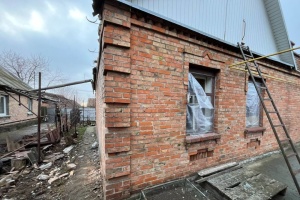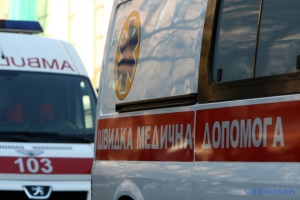
Flooded land and burned down forests: Russians “fighting” against environment in Ukraine
Russia’s full-scale invasion of Ukraine has become the largest military conflict in Europe since World War II. The hostilities, in which hundreds of thousands of combatants, a significant amount of military equipment, and all types of conventional weapons are involved on both sides, continue on the territory of Ukraine, causing great damage to the state and its citizens. The environment – air, water, and land resources, forests, protected areas, wildlife, and flora – has also suffered greatly. The most notorious crime the occupiers committed against the environment in Ukraine was when they blew up the Kakhovka hydroelectric power plant on June 6, 2023, which led to an environmental catastrophe in the South of Ukraine. This can be qualified as an act of ecocide.
The estimated amount of damage caused to the environment during the full-scale war, according to the estimates of the State Environmental Inspectorate, is close to UAH 2 trillion. However, it is now difficult to assess the true scale of Russian crimes because the hostilities continue and part of the territory remains under occupation. Obviously, this has already led to long-term negative consequences for the environmental situation in Ukraine and in the world. Overcoming the consequences will require enormous resources. This is a challenge that must be met not only by Ukraine, but also by the international community.
The Center for Strategic Communication and Information Security collected information about Russian crimes against the environment and key environmental problems caused by the war.
Air pollution reports
Hostilities are accompanied by fires and explosions, which lead to atmospheric pollution. Millions of tons of emissions and combustion products enter the air and accelerate climate change: in just one year of hostilities, 33 million tons of greenhouse gases were released into the atmosphere.
The full-scale war is accompanied by attempts by Russians to destroy Ukrainian ammunition depots, oil depots, oil refineries, and other chemical industry facilities.
Here are just a few examples: On February 27, 2022, a Russian ballistic missile hit an oil depot near Vasylkiv in Kyiv Oblast. During March-April of the same year, Russians attacked oil depots in Chernihiv, Zhytomyr, Kyiv, Lviv, Rivne, Dnipropetrovsk, Volyn, Luhansk, Poltava oblasts.
Together with carbon monoxide, during the combustion of petroleum products, benzopyrene, sulphur dioxide and trioxide, vanadium compounds, sodium salts, aldehydes, soot, etc., enter the atmosphere. All these compounds are highly toxic, they harm people, flora and fauna, and pollute soil and reservoirs.
Nuclear facilities captured, sustaining damage
Russian invaders resort to nuclear terrorism: they strike at nuclear facilities, seize them, and use them as military bases, holding personnel hostage.
In the first days of the full-scale invasion, the enemy seized the Chornobyl nuclear power plant. On February 25, a sharp surge in radiation was recorded in the exclusion zone: its level rose 20 times. This was due to the Russian military’s disregard for radiation safety standards: they moved around the Chornobyl zone on heavy equipment, dug trenches, in particular in the Red Forest, raising radioactive dust into the atmosphere, and provoked several fires. The Chornobyl NPP has been under Russian control for more than a month. The occupiers killed nine and kidnapped five employees of the station, and took 169 captured soldiers of the National Guard who guarded the facility. In addition, the Russians damaged and stole hundreds of computers, software, 1,500 dosimetry devices and firefighting equipment. This caused damage to the security system of the Chornobyl NPP, the amount of damage exceeds USD 135 million.
In March 2022, the Russians seized the Zaporizhzhia nuclear power plant in Enerhodar and took its personnel hostage. The occupiers turned Europe’s largest nuclear power plant into a military base. They placed artillery and air defence systems on the territory of the nuclear power plant. Russian troops use the ZNPP as a “nuclear shield” to shell Marhanets and Nikopol from its territory, knowing that they will not be shelled in response. Weapons and ammunition are stored near reactors and containers with spent nuclear fuel, posing a threat of man-made disaster. Pressure on personnel and improper operation of ZNPP equipment also increase the risk of accidents due to the “human factor.” And after the blow-up of the Kakhovka HPP, mined earlier by them, the Russians increased the risks of disabling the cooling system of the ZNPP reactors, which could lead to catastrophic consequences.
During the battles for Kharkiv in spring and summer 2022, Russian troops targeted the Neutron Source nuclear facility on the territory of the Kharkiv Institute of Physics and Technology several times. The installation itself was hit, with 37 fuel cells loaded. Its damage and destruction of nuclear material repositories could lead to a large-scale environmental disaster.
Lands infested by mines, soil affected
Numerous artillery and missile and bomb strikes not only contaminate Ukrainian soils with debris and rocket fuel, but also damage their structure, forming deep tears.
About 174,000 square kilometres, almost a third of the territory of Ukraine, are potentially contaminated with explosive objects. The worst situation is in Donetsk, Zaporizhzhia, Kyiv, Luhansk, Mykolaiv, Kharkiv, Kherson oblasts. About 470,000 hectares of agricultural land in Ukraine were subjected to mine contamination. This poses a threat to global food security.
The level of mine contamination in Ukraine is the largest in Europe, demining can take decades.
Reservoirs being polluted
Due to Russian aggression, the quality of Ukrainian water resources is depleting. Ammunition, oil products, human and animal bodies end up in the reservoirs, while the coasts are infested with mines. The pollution of the waters of the Dnipro and the Black Sea was caused by the blow-up of the Kakhovka HPP; people’s homes, agricultural land, cemeteries, and cattle burial grounds were in the flood zone. Chemical fertilizers, fuel and lubricant materials and other pollutants, the bodies of dead people and corpses of animals got into the water. For decades, heavy metals and other harmful substances from the emissions of industrial enterprises of Zaporizhzhia and Dnipro accumulated in the bottom sediments of the reservoir. Contamination of freshwater during summer heat can cause water to bloom. The release of a large amount of river water threatens the temporary desalination of parts of the Black Sea, causing its flora and fauna to suffer.
Missile and bomb strikes on Ukrainian cities have caused dozens of damage to pipelines, pumping stations, and treatment facilities. This has led to the pollution of reservoirs, hundreds of thousands of people were left without access to safe water.
The scale of groundwater pollution will still have to be assessed in the future.
Forests and protected areas being destroyed
As of the end of 2022, 3 million hectares of forest were destroyed and damaged as a result of the war — a third of the forest fund of Ukraine. According to environmentalists, its restoration may take at least 20 years.
Some 160 objects of the Emerald Network, which is 2.9 million hectares of Europe’s environmental network, are under threat of destruction. A third of the national protected areas of Ukraine are affected by the war. 900 reserve territories are at risk. This is 1.2 million hectares, or more than a quarter of all protected areas of the country. The destruction of objects of the nature reserve fund (NRF) leads to the extinction of unique ecosystems, which are almost impossible to restore.
One of the biggest crimes of the occupiers against the NRF is the destruction of the ecosystem of the Kinburn Spit, which is washed by the waters of the Black Sea, the Dnipro-Bug estuary, and the Yahorlytska Bay. Relict forests, floodlands and swamplands, fresh and salt lakes, solonetzic soils, and salt marshes, natural spawning grounds, virgin areas of the sandy steppe are preserved here. 415 rare species of animals were found on the spit, 166 of which are listed in the Red Data Book of Ukraine, 47 rare species of plants, fungi, and lichens. In the first eight months of the occupation alone, according to the human rights organization Environment People Law, 30% of the Kinburn forests — 10,000 hectares — were affected by the fire.
The ecosystem of Snake Island, which has the status of a reserve of national importance, has suffered irreparable losses.
Animals dying
Hostilities, shelling and ensuing fires, as well as the flooding of territories, lead to the mass death of wild and domestic animals. Dozens of species are facing extinction, and due to Russian aggression, there is nothing that environmentalists can do to help them.
Scientists record the negative impact of war on the populations of animals, birds, fish, and amphibians. The population of dolphins in the Black Sea must have been affected the most. Ivan Rusiev, head of the research department of the Tuzlivski Lymany National Nature Park, reported the death of 50,000 species in autumn 2022 — 20% of the entire Black Sea population. The reason for the death of dolphins, according to the scientist, was a large number of ships’ sonars of the Russian Black Sea Fleet and explosions. This hypothesis is confirmed by the results of studies of Romanian ecologists: in half of the cases during necropsy in animals, damage to the bones of the inner ear was found.
The breach of the Kakhovka HPP has led to catastrophic consequences for biodiversity. Spawning grounds and habitat of more than 40 species of fish were destroyed. Due to the dehydration of the reservoir, not only fish died, but also other inhabitants of the reservoir: mollusks and various species of flies, which are the fodder base for fish, birds, amphibians, etc. Birds that nested on isolated islands, to which predators did not have land access, are in danger of extinction. We are talking about the Eurasian oystercatcher, squacco heron, spoonbill, and other rare species.
The rapid flooding of the territory downstream of the Dnipro left no chance of survival for local mammals, reptiles, insects, colonies of most bird species. Water has destroyed up to 70% of the world population of Nordmann’s birch mouse, which can lead to its complete extinction. Up to 50% of the populations of sandy blind mole-rat and stylodipus have been exterminated. They, as well as the vipera renardi and the Caspian whipsnake, do not have the opportunity to escape in a rapid flow. The lower reaches of the Dnipro are home the largest colonies of herons and other colonial birds. The disaster occurred during the period of nesting and hatching. They have no time to create new colonies and other broods.
The methods used by Russia to wage a war against Ukraine show that the Kremlin not only seeks to destroy Ukrainian statehood, but also to make the territory of Ukraine uninhabitable. Russian troops resort to the tactics of “the scorched earth” and deliberately commit crimes against the environment. Bringing the perpetrators of these crimes to justice is no longer only a matter for Ukraine, but for the entire international community. After all, the consequences of the war will inevitably affect the environmental situation in the world.
Center for Strategic Communication and Information Security




